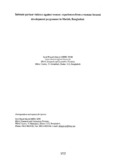| dc.contributor.author | Ahmed, Syed Masud | |
| dc.date.accessioned | 2020-01-09T07:30:11Z | |
| dc.date.available | 2020-01-09T07:30:11Z | |
| dc.date.issued | 2002 | |
| dc.identifier.citation | Ahmed, S. M. (2002). Intimate partner violence against women: experiences from a woman-focused development programme in Matlab, Bangladesh. Research Reports (2002): Social Studies, Vol – XXX, 352–367. | en_US |
| dc.identifier.uri | http://hdl.handle.net/10361/13441 | |
| dc.description.abstract | Objective: This paper explores the effect of a credit-based development interventions on violence
against women (excluding sexual violence) perpetrated by husband.
Methods: Data for this study originated from a cross-sectional survey conducted during 1999 in 60
BRAC-ICDDR,B study villages in MatIab, Bangladesh. Pre-tested structured questionnaires were used
for data collection. Questions elicited information on both physical and mental violence perpetrated by
husband during the preceding four months. Data were analysed to characterise group-level differences
among the study women in the occurrence of violence and also, to identify its predictors.
Findings: About 17.5% women reported having suffered violence from their husbands in the past four
months, the proportion being greater among the BRAC households (p=O.05). In logistic regression, two
models were tested. The results identified age (probability less as age increases), schooling (probability
less if some schooling), household head's occupation (probability more with wage labour) and
household's perceived solvency (probability more if deficit household) as important predictors in both
the models. In the first model, involvement in BRAC was found to be a risk factor while in the second
model, prevalence of violence lessened with improvement in the depth of membership such as receiving
skill-training for various income-earning activities, in addition to involvement in savings and credit
activities. This also indicated that the level of violence decreased with the duration of membership
because with the ageing of membership, inputs like skill-training are added to the intervention package.
Conclusion: Domestic violence decreases as women becomes empowered through capacity development
interventions of microcredit organisations over time. | en_US |
| dc.language.iso | en | en_US |
| dc.publisher | BRAC Research and Evaluation Division (RED) | en_US |
| dc.subject | Violence | en_US |
| dc.subject | Domestic violence | en_US |
| dc.subject | Intimate partner violence | en_US |
| dc.subject | Empowerment | en_US |
| dc.subject | Micro-credit | en_US |
| dc.subject | BRAC | en_US |
| dc.subject | Bangladesh | en_US |
| dc.subject.lcsh | Wife abuse | |
| dc.subject.lcsh | Family violence | |
| dc.subject.lcsh | Marital violence | |
| dc.subject.lcsh | Women -- Violence against -- Bangladesh. | |
| dc.title | Intimate partner violence against women: experiences from a woman-focused development programme in Matlab, Bangladesh | en_US |
| dc.type | Research report | en_US |

